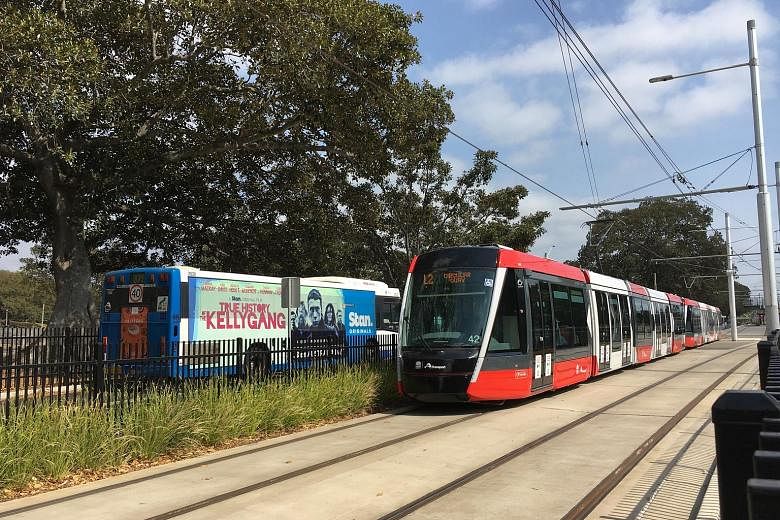Sixty-one years ago, the last tram rode through George Street in the centre of Sydney before the line was demolished to make way for buses and cars.
But now, trams are back on the busy thoroughfare as part of a new A$2.96 billion (S$2.8 billion) line to the city's eastern suburbs.
The 19-stop, 12km tram, or light rail, line opened last weekend. It starts from Circular Quay and then runs along George Street - the site of the city's earliest electric tram line, built in 1899 - before heading to the suburbs.
But the line has already faced several hurdles. It was finished about a year late and cost almost double the scheduled A$1.6 billion.
The New South Wales government faces a A$400 million class action suit from businesses disrupted by the construction, which made roads noisy and difficult to access.
Retailers were heavily affected because George Street is one of Australia's busiest streets, and the line also runs through the busy shopping and cafe district of Surry Hills.
But the main concern has been speed. Despite travellers praising and largely welcoming the much-needed addition to Sydney's public transport system, the new line has come under heavy criticism over its slow pace.
Travel between Circular Quay and the suburb of Randwick takes almost 50 minutes. This is up to 20 minutes slower than taking a bus and 24 minutes slower than the original trams in the 1950s.
Several disruptions occurred during the first week of operation, including a tram breaking down, another being briefly driven down the wrong track and a power failure affecting services on a stretch.
The state's opposition Labor Party has denounced the line as the "slowest and most expensive light rail system anywhere in the world".
"It is quicker to run, cycle or catch a bus from Randwick to Circular Quay, which makes this project an embarrassment," Labor MP Chris Minns told news.com.au
The government says it plans to reduce the travel time to about 40 minutes over the next six months.
The state's Transport Minister Andrew Constance said the speed would increase as travellers adjust to boarding and alighting from the trams. "I would hope the trams will start to speed up as people get used to them, but it's not going to happen on day dot," he said.
"People need to get used to pressing the buttons on the doors. It's not like a bus."
Sydney, a sprawling city of about five million residents, has suffered from worsening congestion as the population grows. Many parts of the city have long experienced inadequate public transport services, though the state government has been investing in large-scale heavy rail and light rail projects. Aside from the new tram line, a separate service goes from Circular Quay to the inner-western suburbs. That line opened in 1997 and was extended in 2014.
A report released last month by the Committee of Sydney showed that about 65 per cent of residents' trips to work are taken by car, 28 per cent by public transport, and 5 per cent by walking, with the remainder by cycling or other modes of transport.
In Singapore, 29 per cent are taken by car, 44 per cent by public transport, and 22 per cent by walking, and the remainder by cycling or other modes of transport.
"Although Sydney is undergoing a substantial cycle of investment in the public transport system and a major restructuring of transport delivery, Sydney's peers are also making rapid progress," the report said.
"But the effect of the arrival of this new infrastructure on Sydney's recorded performance may take time to register… The risk is that Sydney's reputation for congestion and inefficiency overshadows its appeal as a productive and attractive city in which to live and work."
Some commentators have questioned the decision to expand Sydney's roads, rather than focus on public transport. There are also growing calls for a congestion tax to be imposed in the city centre.
The new trams are due to run every four to eight minutes in the city centre during peak periods. Each tram vehicle is 67m long and can carry up to 450 passengers. The full 19 stops on the new line will operate from March next year.
Transport expert Greg Sutherland believes the "inordinate slowness" of the new line is due to poor planning. He said the tram took too long pulling into stops and spent too long a period at each one, adding that traffic-light signalling failed to give sufficient priority to the trams.
"Priority for trams at signalled intersections is, at best, rudimentary," he wrote in The Sydney Morning Herald, saying that "415 passengers have less priority than a handful of cars, each with an average of 1.1 occupants".
But the other looming question is why the new line needed to be built at all. Sydney once had an expansive network that was widely used, until officials decided to demolish it in the 1950s to make way for cars.

